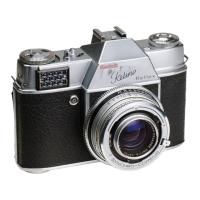Viewing and Focusing
The image reflected by the lens on to the screen is only visible after winding the shutter. It disappears once the
shutter is released. This indicates at the same time whether the camera is ready for the next exposure, as
winding the shutter also advances the film. The reflex image is large and brilliant and appears almost in natural
size; it is free from parallax. A viewing pentaprism shows the image upright and right-way-round at eye-level.
The centre of the reflex finder image contains a clear circle. This centre circle is cut in half by a horizontal line
and acts as a split image rangefinder. The distance to the subject can be measured in two ways.
First, by observing through the centre circle of the reflex finder a vertical line of the subject to be focused e.g.,
a tree, edge of a wall, outline of a person and suchlike. On turning the camera focusing mount (the serrated ring
on the lens mount nearest to the camera body) the image in the upper half moves in relation to the lower half of
the circle. The lens is focused correctly when the two halves are exactly in line with each other. If the camera is
held vertically, choose a horizontal line of the subject; the centre appears split vertically, otherwise the
procedure is the same as described above.
Alternatively, and particularly if the subject does not show any prominent vertical or horizontal lines, observe the
image on the ground glass which surrounds the circle. Turn the lens mount until the image of the subject
appears perfectly sharp on the ground glass.
Whilst focusing with the split image rangefinder is quite straightforward, some experience is required to obtain
the best definition quickly when using the ground glass method. The best way to arrive at critical definition is to
turn the focusing ring of the lens mount slowly to and fro while observing on the ground glass the subject to be
focused. As you turn the focusing mount, the image becomes more and more sharp up to a certain point,
beyond which it will again lose definition. At this "beyond" stage, turn the mount back again, narrowing down
the degree of movement until you arrive at the point of best definition.
The orthodox way of focusing with either split field range-finder or ground glass may be adopted for taking
photographs of subjects that are fairly stationary. A different method of focusing is required when taking
subjects in motion. Set the rangefinder to a distance at which the subject will be in a given moment, or focus at
some spot which it actually has to pass, and press the release button when the subject is reaching the pre-
focused point. With subjects liable to react self-consciously (e.g., children) set the lens to a suitable distance,
and then approach the subject quickly, exposing as soon as the ground glass image appears sharp, or the two
halves of the rangefinder are in line with each other.
Alternatively, focus at some object which is at the same distance from the camera as the subject, but in a
different direction, and when the range is found swing round to press the release button as soon as the victim
slips into the field of view of the finder. See also quick shooting with zone focusing (p.41).
FOCUSING AND VIEWING
The Retina Reflex is a single lens reflex camera with (on the current model) fully interchangeable lenses. The
section through the camera (above) shows the main components of the optical system. The heavy arrowed line
indicates the path of the light from the lens to the finder.

